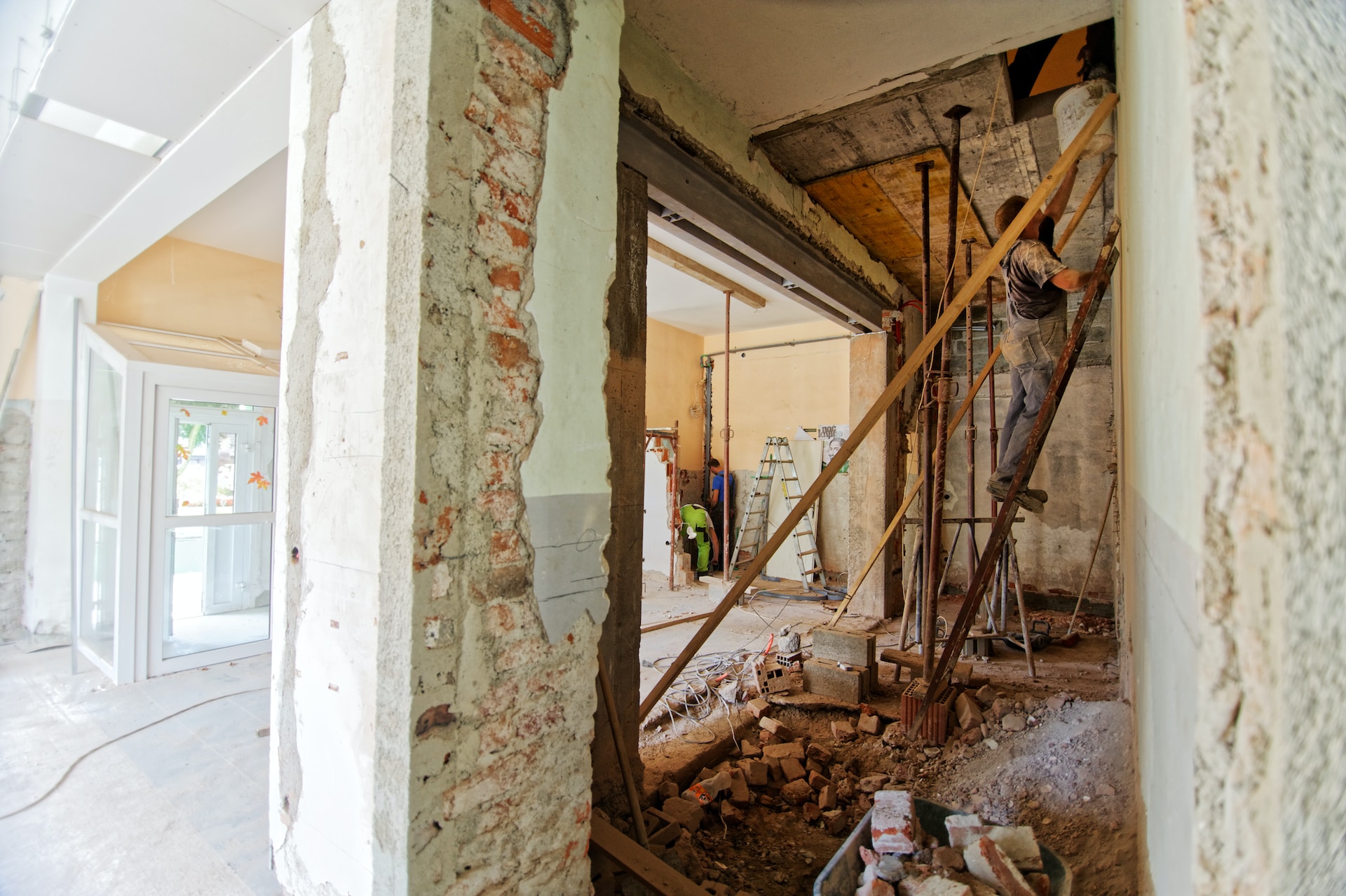If you want to improve the comfort or functionality of your property, you’ve likely given some thought to remodeling it to better suit your needs. The downside is these projects can be very expensive, and you may not have the cash on hand to cover the costs outright.
Fortunately, there are several loans that cater to homeowners looking to renovate their homes. As with any debt product, they come at a cost but could be well worth it. You’ll get a more comfortable space that works for both you and your family. Plus, you won’t have to exhaust your reserves and could increase the value of your property. The latter could be quite beneficial if you decide to sell in the near future since property values have increased significantly over the past few years.
In this guide, you’ll discover the key benefits of taking out a loan to remodel your home, explore loan options and learn how to evaluate each to find the best fit. Plus, you’ll learn what to expect when navigating the lending process.
What is a Home Remodel Loan and How Do They Work?
A home remodel loan can be a helpful solution for financing your projects without draining your savings. These types of loans are designed to help you undertake necessary improvements and enhance the value of your home.
The Benefits of Getting a Loan to Remodel Home
If you’re considering taking a loan to remodel your home, there are several key advantages of this approach to be aware of.
One of the primary benefits of a home remodeling loan is that it can help increase your home’s value. As you invest in home improvements like kitchen renovations and bathroom upgrades, your property will likely become more attractive to buyers, leading to a higher resale value. Furthermore, enhancing your home’s energy efficiency through improvements like installing new windows or upgrading your HVAC system can boost your property value even more.
Another advantage of getting a loan to remodel your home is the opportunity to customize your living space according to your preferences and needs. Home renovation projects can help you create the perfect environment for you and your family. Whether you’re interested in adding more space, updating outdated features, or making your home more accessible to all family members, a remodeling loan can make your dream living space possible.
Securing a loan to remodel your home may also benefit your financial situation. If you choose to utilize home equity for financing, you can potentially benefit from lower interest rates compared to other types of loans. This can result in lower monthly payments that are much easier to work into your budget.
Types of Loans to Remodel Home
Before shopping around for a loan, you should understand the options that could be available to you. These include home equity loans for remodeling, construction loans for home renovations, personal loans for home improvement, home equity lines of credit (HELOCs) for remodeling and FHA 203(k) Rehab Loans.
Home Equity Loans for Remodeling
Home equity loans are a popular option for financing home renovations. These loans are based on the amount of equity you have in your home and use your home as collateral. Home equity loans usually have a fixed interest rate and repayment term, making them a stable option for financing your remodel. But there’s a significant downside. If you fall behind on the loan payments, the lender could foreclose your home.
Construction Loans for Home Renovations
Construction loans are short-term loans used to finance the building or renovation of a home. They work differently from traditional mortgages and have shorter repayment terms, usually around a year or less. As you complete different stages of your renovation project, you can request funds from the lender to cover your expenses. The interest rates for construction loans are typically higher than those of home equity loans, so it’s essential to understand the borrowing costs before moving forward with this form of financing.
Personal Loans for Home Improvement
Personal loans for home improvements are another financing option that doesn’t rely on home equity. These loans are based on your creditworthiness and have flexible terms. Personal loans can be secured or unsecured, but unsecured home improvement loans have higher interest rates due to the increased risk for the lender.
Home Equity Line of Credit (HELOC) for Remodeling
A home equity line of credit (HELOC) is another financing option that uses your home as collateral. It works like a credit card, allowing you to access funds up to a specific credit limit. You can draw from your HELOC during a specified period and make interest-only payments on the amount you borrow. After the draw period, you’ll need to begin repaying the principal as well. HELOCs are helpful when you need flexibility in financing your home remodeling project. Keep in mind that the interest rate is variable so that you can expect a fluctuating monthly loan payment.
FHA 203(k) Rehab Loans
An FHA 203(k), backed by the Federal Housing Administration (FHA), is designed specifically for home renovations. These loans can be used to buy a property that needs work or to refinance your current mortgage and fund the necessary improvements. FHA 203(k) loans have more lenient credit and down payment requirements and can be a great option if you have a less-than-perfect credit score. Keep in mind that these loans have some restrictions, such as a requirement to work with approved contractors.
How To Get A Loan to Remodel Home
When considering a loan to remodel your home, it’s crucial to evaluate your financial standing. Take time to assess your credit score, as it plays a major role in the types of loans you’re eligible for and the interest rates you’ll receive. Plus, a higher credit score often results in more favorable loan terms.
Begin by researching different lenders who offer loans for home renovations. Explore offerings from banks, credit unions and online lenders. Each may feature diverse loan programs, rates, and terms, so it’s essential to weigh your options and compare them to find the best fit for your unique needs.
Also, be realistic about the loan amount you need for your project. Consider getting quotes from contractors to get a better understanding of the costs associated with your home remodel. It’s equally important to ensure the loan amount is suitable for your specific renovation plans and budget without causing unnecessary financial strain.
You should also know that applying for the loan involves submitting your financial information, income details, credit history and the scope of the remodel project. Once approved, you’ll need to carefully review the loan agreement, including interest rates, repayment terms, and any additional fees, before signing. It’s vital to have a clear understanding of the loan terms to avoid any surprises later on down the line.
While a personal loan or a home renovation loan might be an ideal choice for funding your remodel, you could also consider using a credit card with a low or zero interest rate, particularly for smaller projects. Keep in mind that credit card interest rates can be higher than other financing options, so be sure to pay off the balance as quickly as possible to minimize interest costs.
Exploring the Types of Home Remodel Loans
Before formally applying for a home remodel loan, there are a few more steps to take to help streamline the process.
Choosing the Right Home Remodel Loan
When planning a home remodel, it’s essential to find the most suitable loan for your specific needs. Assess your requirements, financial situation and credit score to choose the best option for your project.
Considering your Financial Situation
Take a close look at your financial situation. Your credit score will play an essential role in determining the interest rates and terms you’ll receive. Keep in mind that a higher credit score generally leads to better loan options and lower interest rates.
Analyzing Interest Rates and Loan Terms
Pay attention to the interest rates and loan terms of various home remodel loans. A lower interest rate will reduce the overall cost of the loan. However, it’s also essential to review the loan terms, such as the repayment period and any prepayment penalties.
Understanding the Implications of Secured vs. Unsecured Loans
You should also understand the differences between secured and unsecured loans. A secured loan will require collateral, such as your home, while an unsecured loan doesn’t require any collateral. A secured loan, like a HELOC, will typically offer lower interest rates but involves more risk, as your home could be in jeopardy if you default on the loan. By contrast, unsecured loans, like personal loans, often come with higher interest rates but don’t require collateral.
Setting your Remodeling Goals
It’s also worthwhile to set remodeling goals before applying for financing so you’ll know how much funding you need to complete your projects.
Defining your Renovation Objectives
Consider the purpose of your remodel. Is it to provide more comfort for your growing family? Do you want to update your home’s style or make the space more suitable to care for a loved one? Or is it to increase the overall value of your property? Determining your objectives will help you plan and prioritize the various aspects of your renovation.
Estimating the Costs of Your Home Remodel
Once you’ve defined your renovation objectives, it’s time to estimate the costs associated with your home remodel. Research and gather quotes from various contractors, suppliers, general contractors and other construction professionals. Be sure to compare prices for materials and labor to get a clear understanding of the total expenses involved.
Here’s a closer look at some factors to consider when estimating costs:
- Material costs: Research the costs of the materials required for your project, such as flooring, fixtures, and appliances.
- Labor: Get quotes from multiple contractors to help you determine the expected labor costs.
- Permits and fees: Check with your local municipality to find out if you need any permits or if there are any fees associated with your remodel.
- Contingency: Set aside a percentage of your budget as a contingency fund for unexpected expenses or cost overruns.
By thoroughly estimating the costs of your home remodel, you can better understand the financial implications and plan your renovation accordingly.
Navigating the Loan Process
The final step before commencing the remodel is the lending process. Below is an overview of the eligibility guidelines and what to expect when you apply for a loan.
Common Requirements for Loan Approval
When you are looking to finance your home remodel, there are a few common requirements that lenders look for before approving your loan. For starters, you’ll need a good credit score as it demonstrates to lenders that you have a history of responsibly managing debt. You should also have a stable income to comfortably pay for your current debts and the monthly payment for the new loan.
Another factor that lenders consider is the loan-to-value ratio (LTV), which is a percentage of the appraised value of your home. The usual limit is 80 percent, meaning you can borrow up to 80 percent of your home’s value. It’s important to note that lender expectations may vary, so it’s always a good idea to consult with multiple lenders to understand their specific requirements.
Applying for a Home Remodel Loan
When applying for a home remodel loan, start by finding a lender that offers the type of loan you’re interested in. Ideally, you should get preapproved with at least three lenders so you can compare rates and terms. Gather the necessary documents, such as pay stubs, tax returns and bank statements. You should also be prepared to provide information about your renovation project and its expected costs.
As you navigate the loan process, keep in mind that each lender may have slightly different requirements and terms. By researching and comparing multiple options, you can find the best fit for your financial situation and home remodeling needs.







